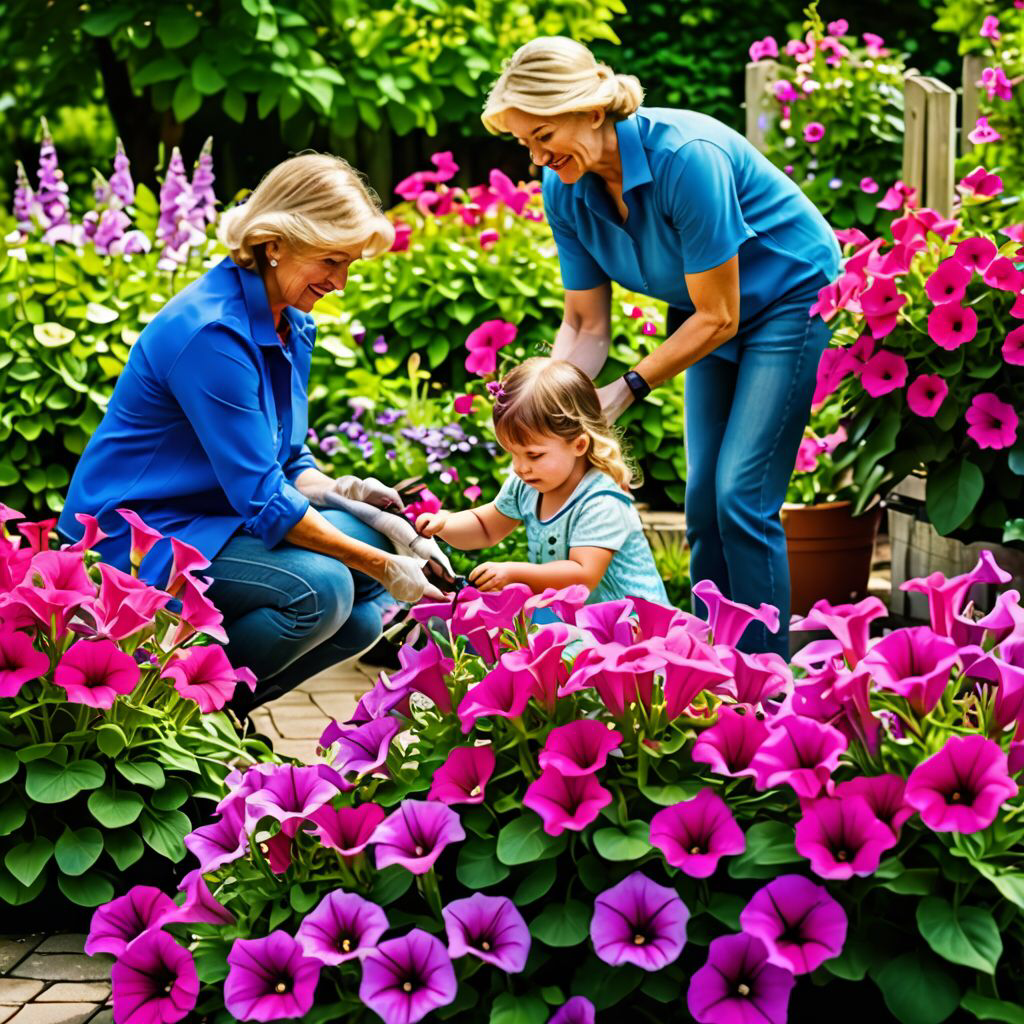
Table of Contents:
1. Introduction
2. Understanding the Basics: Annuals and Perennials
- 2.1 What are Annuals?
- 2.2 What are Perennials?
3. Choosing the Right Plants for Your Winnipeg Landscape Design
- 3.1 Climate Considerations
- 3.2 Soil Quality and Preparation
- 3.3 Light Requirements
4. Best Combinations of Annuals and Perennials
- 4.1 Seasonal Color: Maximizing Impact
- 4.2 Themes and Styles
5. Practical Tips for Incorporating Annuals and Perennials in your Winnipeg Garden Design
- 5.1 Planning Your Garden Layout
- 5.2 Companion Planting: Enhancing Growth and Aesthetics
- 5.3 Unique Flower Bed Designs
6. The Role of Perennial Herbs in Your Garden
- 6.1 Benefits of Growing Herbs
- 6.2 Popular Perennial Herbs to Consider
7. Conclusion
1. Introduction:
Welcome fellow gardening enthusiasts, plant lovers, and curious Winnipeg homeowners! Today, we embark on an exploration of two essential pillars of the garden design universe: annuals and perennials. Now, if you’re anything like me, you probably thought that these two plant categories were as straightforward as they sound. However, the depth of their interaction and their roles in landscaping Winnipeg-Style is richer than a freshly tilled patch of top soil. Whether you’re keen on crafting an awe-inspiring rose garden, any vibrant flower garden, or a serene oasis that invites relaxation with every breeze, understanding how to maximize your landscaping choices is paramount.
As we dive into the weeds (pun intended!) of integrating both annuals and perennials into your home garden design, you may ask, “Why do I even care?” Well, imagine sipping your morning coffee while surrounded by blooming flowers every spring and summer, even as winter whispers it's long, frigid sigh.

Or envision your neighbors peeking over the fence in envy at your vibrant green haven. Designing your garden to include a beautiful blend of both annuals and perennials gives you flexibility, year-round appeal, and yes, even bragging rights. With practical tips that even the busiest of us can implement, we’ll navigate the garden gauntlet of plant selection, design ideas, and maintenance strategies to ensure your garden becomes the talk of the block!
So, pull on those gardening gloves, grab a coffee, and let’s get ready to dig deep into the rich soil of garden ideas and practical wisdom. Whether you're dabbling for the first time or seeking expert advice, this guide will empower you to create a flourishing retreat that speaks to your unique style. Let’s roll up our sleeves and get to the root (another pun, just for fun!) of what makes these plants tick.
2. Understanding the Basics: Annuals and Perennials:
2.1 What are Annuals?
Annuals are the plants that make a splash and then peace out; they complete their entire life cycle in a single year. More specifically, they sprout, bloom, and die all within that twelve-month period, transforming your landscape into a vibrant tapestry of color and life. These beauties boast an incredible ability to provide instant gratification; they flower profusely, setting seed quickly, and can even act as effective fillers in your flower bed design
.
In the context of landscaping near me—especially with our unique Winnipeg Style climate—annuals are often perfect for vibrant summer gardens. They thrive with love and care, yet they can be a bit high-maintenance, requiring regular watering and deadheading to keep them blooming. Think of them as the party-goers who arrive late and leave early but make sure to dance all night long.

Some popular annuals to consider are petunias, marigolds, and zinnias, which can bring a pop of color to any home garden.

2.2 What are Perennials?
Perennials are the reliable friends in your garden – they come back season after season, giving you a sense of continuity and stability in your landscape. While their blooms may last only a short duration each year, they often spring back joyfully, often becoming more robust and beautiful over time. These are plants such as coneflowers, hostas, and daylilies that can offer a wonderful base for your garden come spring after surviving the harsh Winnipeg winter.
An appealing feature of perennials is that once established, they require less maintenance than annuals. They call for less watering, fewer replacements each year, and they naturally integrate into your landscape. Think of them as the long-term investments in your yard maintenance Winnipeg portfolio. You plant them once and enjoy their array of colors and textures for many seasons to come.
Ready to transform your Winnipeg yard with 10-best perennial suggestions?
3. Choosing the Right Plants for Your Landscape Design:
3.1 Climate Considerations
When it comes to backyard landscape design, one of the most critical aspects to consider is your climate. Winnipeg, known for its harsh winters and hot summers, demands that you select your plants carefully. Understanding your USDA Hardiness Zone (Zone 3 for Winnipeg) will guide your plant selection, helping ensure that your garden not only looks good but thrives. Certain annuals may struggle in our climate while hardier perennials reinforce the backbone of your design strategy.
Local gardening stores often provide guidance on which varieties thrive best. Native species, too, can simplify your work since they’re accustomed to local weather. Plus, you’ll enjoy the bonus of supporting local wildlife—who doesn't love a fluttering butterfly or incandescent hummingbird hopping from bloom to bloom?
3.2 Soil Quality and Preparation
Before you dive into planting, you must consider the almighty soil beneath your feet. Good-quality top soil allows your plants to establish strong roots, ensuring their vitality in your landscape. On that note, be sure to amend your soil with organic matter such as compost and well-rotted manure. Soils that are well-drained yet retain moisture will serve your plants best.
To prepare your soil, start by testing its pH, which can usually be purchased at garden centers. Most plants prefer a pH around 6.0 to 7.0. If your soil leans too acidic, consider adding lime; if too alkaline, sulfur might be the hero you need! And don’t forget to clear the area of weeds or debris, as pesky intruders will compete for nutrients, leaving your precious annuals and perennials feeling sad.
Transform your Winnipeg yard with Sunshine Maintenance & Landscaping
3.3 Light Requirements
Not all spaces are created equal, and understanding light is critical in your landscape design efforts. Your garden may get full sun (six or more hours of direct sunlight), partial sun (four to six hours), or shade (less than four hours). Matching the right plants to the right habitat is key if you want to avoid a garden disaster.
Annuals tend to like full sun, but some, like impatiens, thrive in shade. Similarly, many perennials are versatile but check their specific requirements before planting. A well-placed garden might receive ample sunlight during the day, but that doesn’t mean your plants will enjoy it. Adjust and plan accordingly for a vibrant display that lasts well beyond the blooming season.
4. Best Combinations of Annuals and Perennials:
4.1 Seasonal Color: Maximizing Impact
Now that you’ve got a solid understanding of your plants, let’s discuss pairing to create impact! Creativity rules the day. Imagine your flower garden overflowing with color variations, textures, and heights throughout the summer.
For a dynamic display, consider combining early-blooming perennials with mid and late-season annuals. For instance, pair stunning peonies with cheerful marigolds to stretch the blooming season and provide continuity. Or, consider planting vibrant petunias amidst tall foxglove to play with height. This approach offers sustained visual interest that’ll keep you and your neighbors captivated all season long.
4.2 Themes and Styles
For your garden design, incorporating a theme can yield stunning results. Whether you want a romantic English garden, a sleek modern design, or a whimsical cottage vibe, selecting the right combination of annuals and perennials is key.
For example, tropical-themed gardens could incorporate Hibiscus and Cannas for yearly pops of color and height, while the evergreen durability of ornamental grasses creates a backdrop. On the flip side, native gardens using coneflowers and black-eyed Susans will resonate with the natural beauty of Winnipeg’s landscape. By having a clear style in mind, you can select plants that harmonize beautifully rather than create a chaotic collage.
5. Practical Tips for Incorporating Annuals and Perennials:
5.1 Planning Your Garden Layout
Planning is half the battle. A good layout will dramatically influence the success of your home garden design. Start with a rough sketch of your garden space, marking areas of sunlight, wind, and landscaping elements like walkways or established trees. Think about the heights of your annuals and perennials, ensuring the tallest varieties are at the back or centerpiece of flower beds, and that the sun-loving plants nab the brightest spots.
Utilizing a planting grid can help visualize your ideas. For example, if you envision a sea of annual Impatiens, intersperse with hardy, dense perennials like Catmint to help keep everything grounded.
Ready to chat about your landscaping goals?

Reach out by call or text to: 204-229-9789 or click here to submit your information today to arrange a “no obligation” introductory phone call. We look forward to helping you transform your yard.
Tips on how to prepare for a consultation meeting with a landscape contractor
5.2 Companion Planting: Enhancing Growth and Aesthetics
Companion planting isn’t just for vegetables; it's an art in the flowering realm too! Consider pairing certain plants to enhance growth or optimize aesthetics.
For example, planting basil alongside tomatoes can uplift flavor and repel pests while cyclical blooms like daylilies and annual snapdragons complement one another perfectly. However, take care not to pair plants that compete for the same nutrients—this could lead to less than stellar results.
5.3 Unique Flower Bed Designs
Ditch the drab and think outside the (flower) box! Unique flower bed designs can create visually appealing spaces that your family and friends will rave about. Circular or zigzag shapes can break up traditional rectangular lines and add charm.
Curate plant heights and colors such that they blossom harmoniously. A perennial like digitalis (foxglove) can serve as the quirky centerpiece against stunning annuals like Cosmos, creating a fairy-tale-like atmosphere. Visit your local botanical garden for inspiration on creative shapes and color combinations that pop.
6.The Role of Perennial Herbs in Your Garden:
6.1 Benefits of Growing Herbs
While light, organic, and lovely blooms waltz through your landscape, let’s not forget the versatile and practical perennial herbs. Beyond serving you in culinary delights, these plants can add an olfactory delight to your outdoor space. Mints, rosemary, and thyme each have earthy aromas that enhance the atmosphere of your flower bed design while concurrently attracting beneficial insects.
Herbs can seamlessly combine beauty and functionality, making them a must in any savvy gardener’s repertoire!
6.2 Popular Perennial Herbs to Consider
Aiming for a more edible landscape? Look into incorporating perennial culinary herbs. Consider planting:
- Lavender: Not only aromatic but also a top choice for attracting pollinators. It will flourish in top soil that drains well.
- Chives: These vibrant green beauties add onions’ mild flavor while offering seasonal blooms—bonus points for visual appeal!
- Oregano: A flavorful addition to your kitchen, oregano lends itself well to a sunny spot and mixes brilliantly with both annuals and perennials.
With these herbs nestled within your garden, you’ll enjoy both bountiful bloom environments and flavorful bounty for your table!

7. Conclusion:
As we put our trowels down and step back to admire the verdant produce of our efforts, one thing is abundantly clear: the art of combining annuals and perennials offers a unique opportunity for creativity and joy in your Winnipeg landscape design adventures. Whether you’re seeking a tranquil backyard, or a practical herb garden, understanding the role of each category of plants leads not only to botanical beauty but a better, and perhaps easier, gardening experience.
Remember, the keys to success in your green quest lie in understanding your soil, selecting the right plants for your environment, and planning diligently for seasonal transitions. Then let your creativity flourish like one of the flower beds you’ve designed!

So grab your gloves, embrace your garden, and above all, let it grow! With love, attention, and a bit of humor sprinkled in, your garden will bloom and thrive, ensuring that for years to come, you and your neighbors marvel at your handiwork. Here’s to your yard! May it be the talk of the town, filled with charm and the wonders of nature.
Don't miss out! Click here to subscribe today and get the latest blog posts delivered straight to your inbox.



